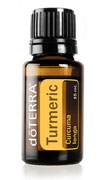The Wonderful Oil that is Turmeric.
You’ve probably heard of turmeric before—it’s the spice that makes curries and mustard yellow in colour. Maybe you’ve even seen it available as a supplement at your local health-food store. That turmeric powder in capsules and spice bottles comes from a root that is dried and ground. However, an option you probably have heard less about is Turmeric essential oil. Turmeric oil is a much more powerful choice when it comes to using this spice for various health benefits.

Turmeric Oil Uses and Benefits
- Turmeric oil may help support a healthy nervous system, as well as cellular function. When you’re feeling like your nervous system is out of balance or needs calming, add Turmeric oil to coconut milk and honey for a delicious drink.
- The soothing benefits of Turmeric oil can be utilized by taking one to two drops in a Veggie Capsule. Doing this on a regular basis gives your body the antioxidant support it needs to protect your body from free radical damage. It may also support healthy immune function as well as immune response.
- It is nearly impossible to go through life without facing some trouble, but we can take control over our emotions. Give yourself a boost by diffusing Turmeric throughout your home to provide yourself with an emotionally uplifting environment and thereby improve your mood.
- Turmeric has the ability to support healthy glucose and lipid metabolism. To better support your metabolism, take one to two drops of Turmeric in at least four ounces of water.
- This spicy oil is actually a wonderful oil to use on your skin. Customize your facial moisturizer by adding a drop of Turmeric before applying, to help support overall clean and healthy looking skin. Turmeric can also be used as a spot treatment to naturally reduce the appearance of blemishes.
- Take advantage of the subtle spicy and peppery flavour of Turmeric by adding a drop or two to scrambled eggs or frittatas, plain rice, or soups. You can also add it to sautéed greens for a peppery flavour.
- Incorporate Turmeric oil into your recovery routine after strenuous activity for a soothing experience. In your palm, add a few drops Turmeric to Fractionated Coconut Oil and massage into your skin where you need relief most.
Plant Description
The turmeric plant is a perennial flowering plant from the ginger family. The plant itself does not grow wild, but where it is cultivated it can grow to more than three feet in height. Both the oil and the root have been used in Asia for thousands of years in Ayurvedic health practices.
Chemistry of Turmeric Oil
Turmeric oil contains the chemical components ar-Turmerone and Turmerone. Both components have been shown to help our bodies with the absorption of curcumin, a strong antioxidant and the main compound actually found in raw turmeric root and turmeric extract.
Sourcing
Sourced from various parts of India and Nepal, turmeric farming is done by both men and women. Women typically task themselves with sorting the harvested turmeric roots into various grades, similar to how women in Somalia sort the resin tears for Frankincense oil.
Oils that Blend Well with Turmeric
Other spice oils blend with Turmeric oil, including Cinnamon Bark, Ginger, and Cardamom. Wild Orange, Grapefruit, and Ylang Ylang are also great blending options.
I am always happy to help you with any questions that you may have on Turmeric – please do just get in touch





